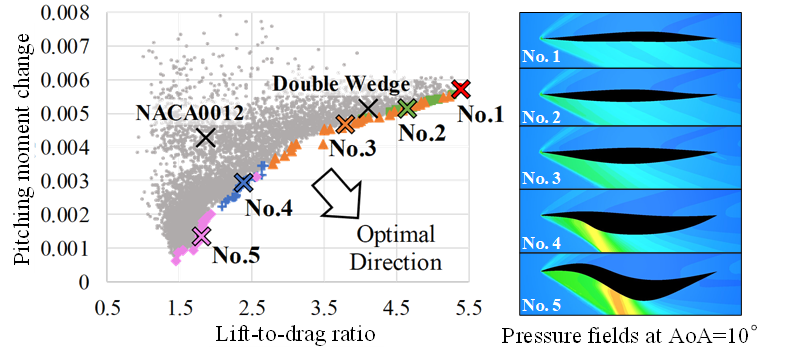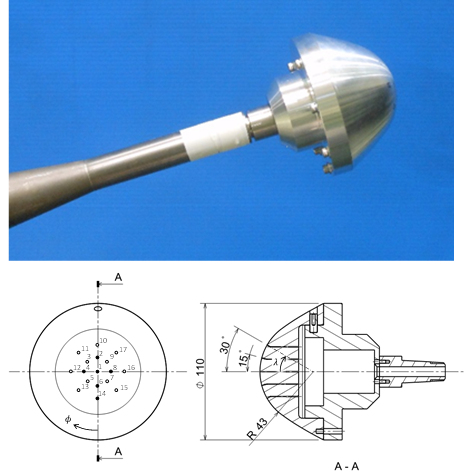High-Speed Aerodynamics
 Flight environments of winged space transportation systems with rocket engines include 1) powered ascent with low angle of attack, 2) reentry with high angle of attack, and 3) gliding with middle angle of attack. In the viewpoint of aerodynamics, therefore, pitching moment characteristics that is responsible for longitudinal trim capability is important along with lift-to-drag ratio. We have conducted multi-objective optimization of supersonic airfoil considering the maximization of lift-to-drag ratio and the minimization of the aerodynamic-center movement. In order to obtain design solutions with high diversity, “dynamically-distributed genetic algorithm” is newly developed and applied. This is a novel genetic algorithm based on island model whose islands are dynamically divided or merged using hierarchical clustering.
Flight environments of winged space transportation systems with rocket engines include 1) powered ascent with low angle of attack, 2) reentry with high angle of attack, and 3) gliding with middle angle of attack. In the viewpoint of aerodynamics, therefore, pitching moment characteristics that is responsible for longitudinal trim capability is important along with lift-to-drag ratio. We have conducted multi-objective optimization of supersonic airfoil considering the maximization of lift-to-drag ratio and the minimization of the aerodynamic-center movement. In order to obtain design solutions with high diversity, “dynamically-distributed genetic algorithm” is newly developed and applied. This is a novel genetic algorithm based on island model whose islands are dynamically divided or merged using hierarchical clustering.
 Pitot tube used in usual aircraft is not applicable to high-speed vehicles due to thermal issues produced by shock waves. We have studied FADS (Flush Air Data Sensing) system, where air data is estimated based on the pressure measurements at several ports installed on the vehicle nose. Especially, our motivation is to develop fault-tolerant FADS system with redundant number of pressure ports and sensors. Research activities include 1) the development of air data estimation algorithm and 2) the wind tunnel tests for collecting calibration data. By using redundant number of ports, it becomes possible to avoid mathematical indefiniteness in conventional estimation procedures and to realize fault-tolerance.
Pitot tube used in usual aircraft is not applicable to high-speed vehicles due to thermal issues produced by shock waves. We have studied FADS (Flush Air Data Sensing) system, where air data is estimated based on the pressure measurements at several ports installed on the vehicle nose. Especially, our motivation is to develop fault-tolerant FADS system with redundant number of pressure ports and sensors. Research activities include 1) the development of air data estimation algorithm and 2) the wind tunnel tests for collecting calibration data. By using redundant number of ports, it becomes possible to avoid mathematical indefiniteness in conventional estimation procedures and to realize fault-tolerance.

